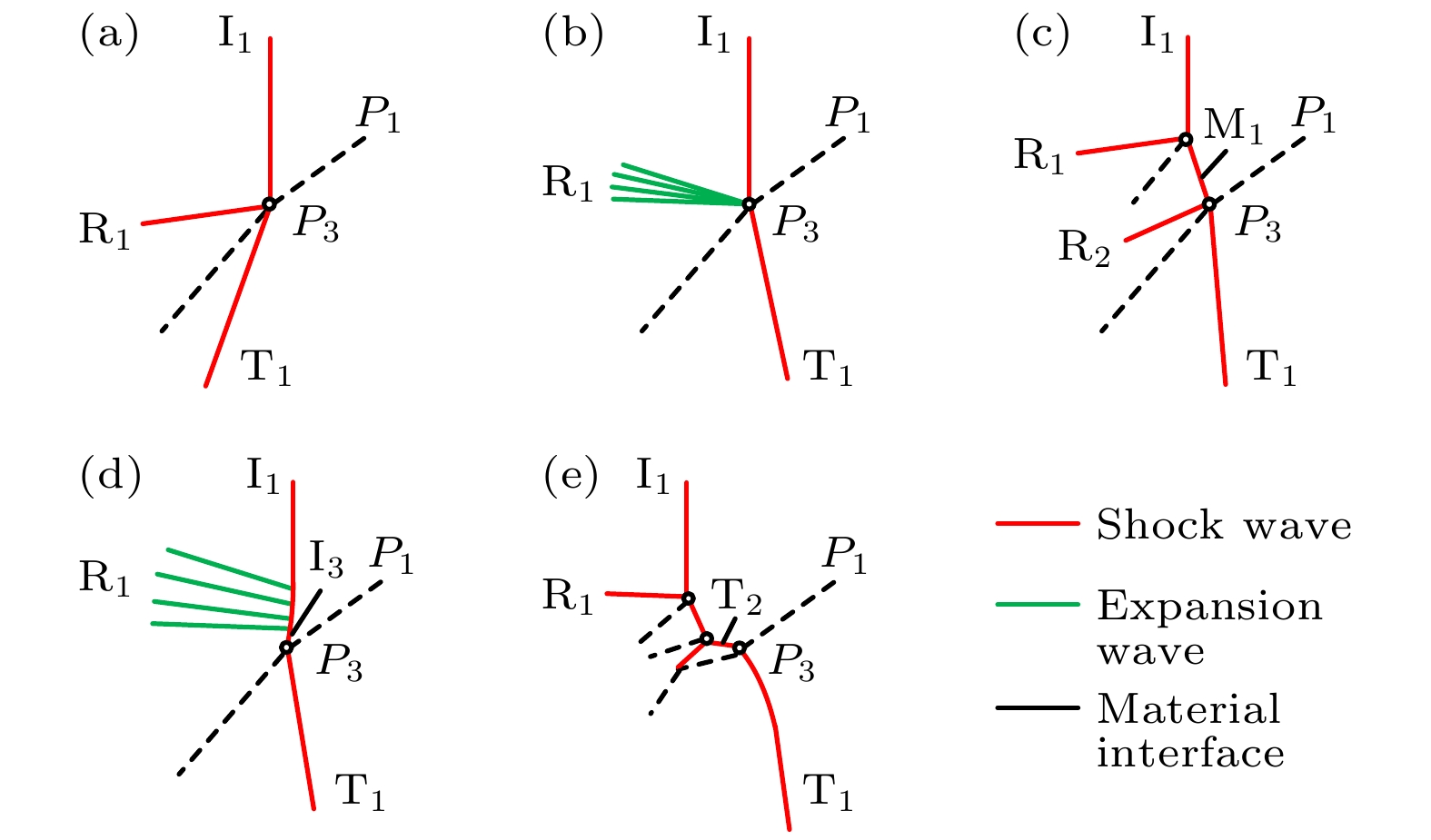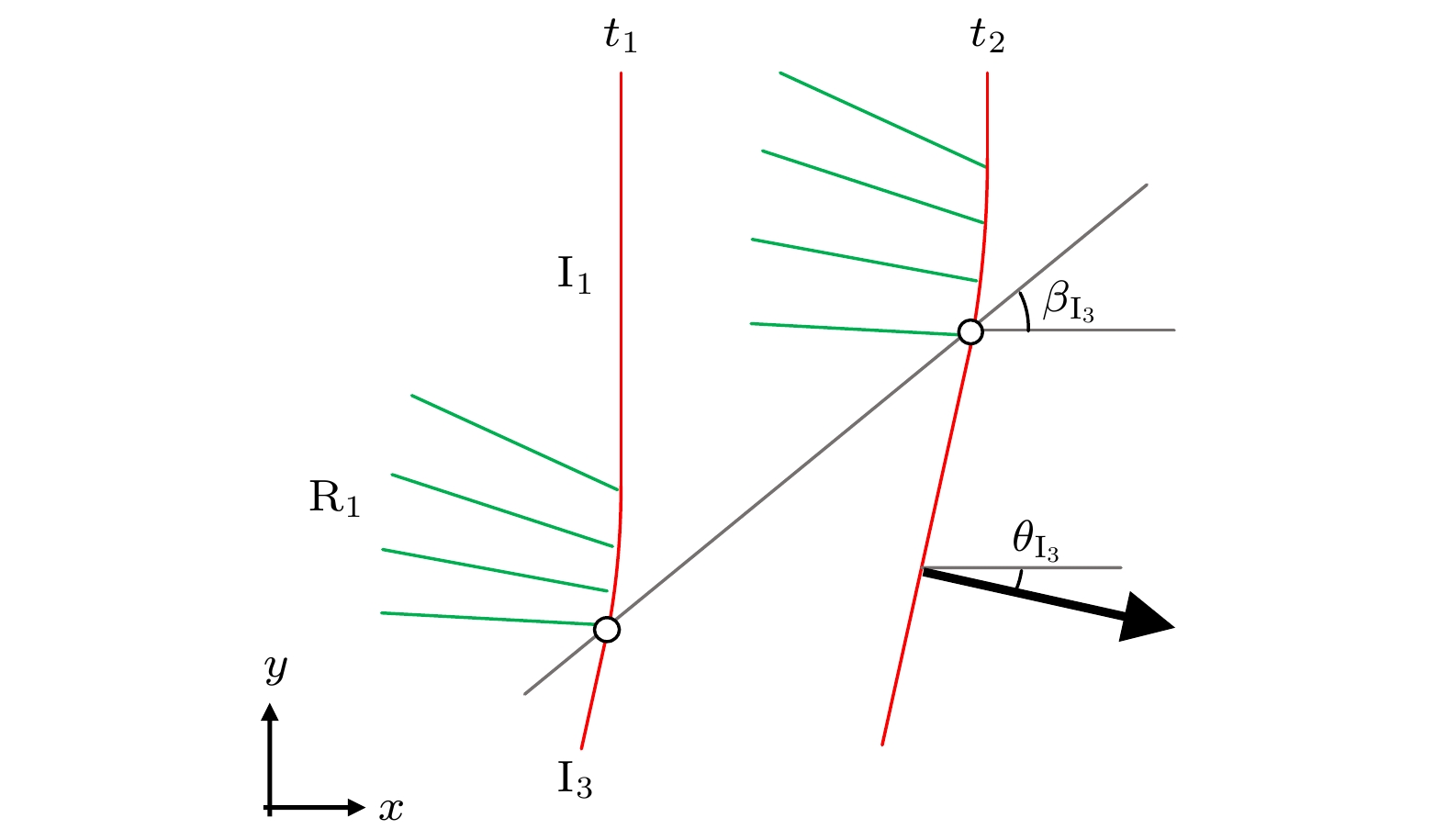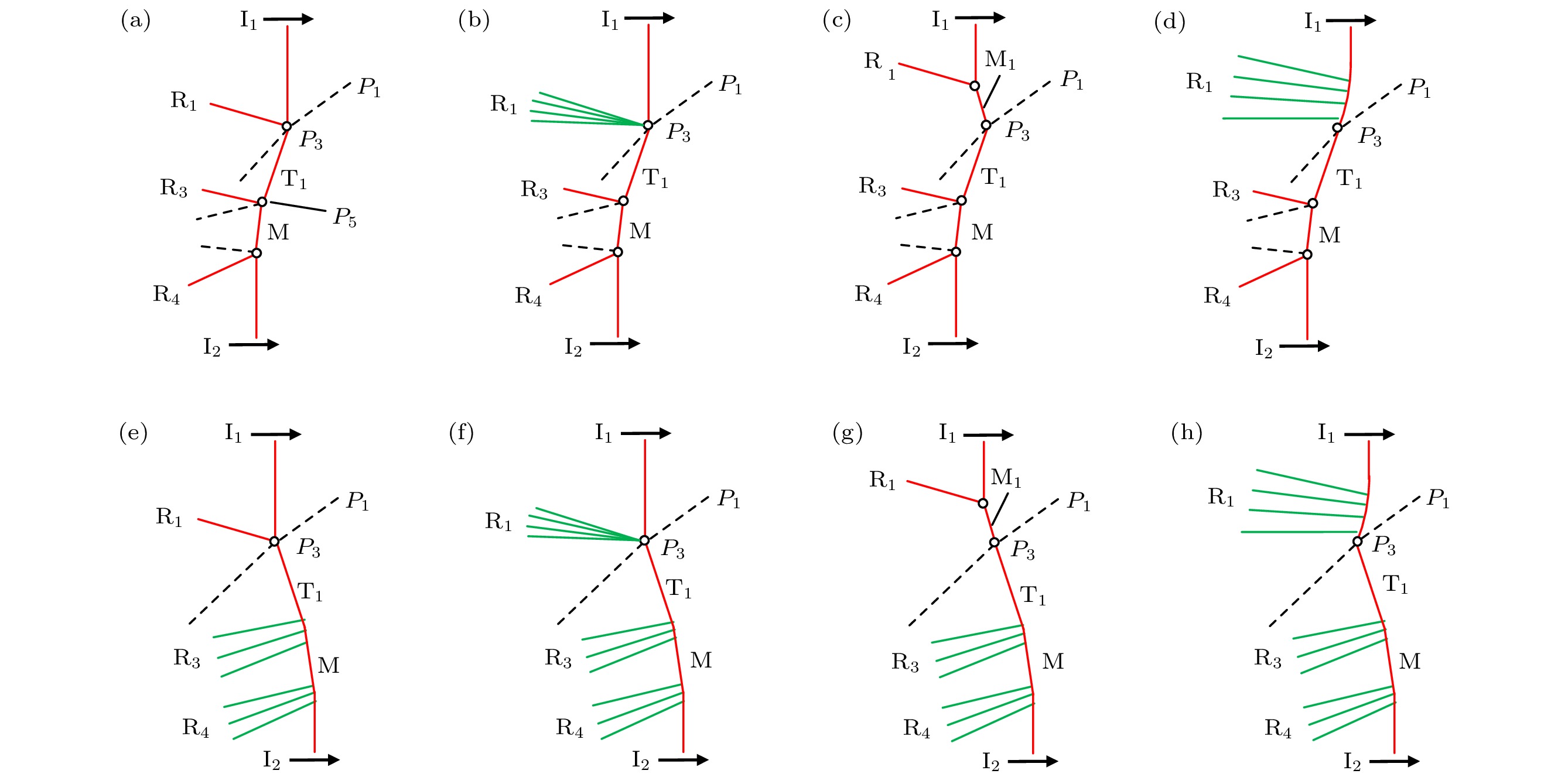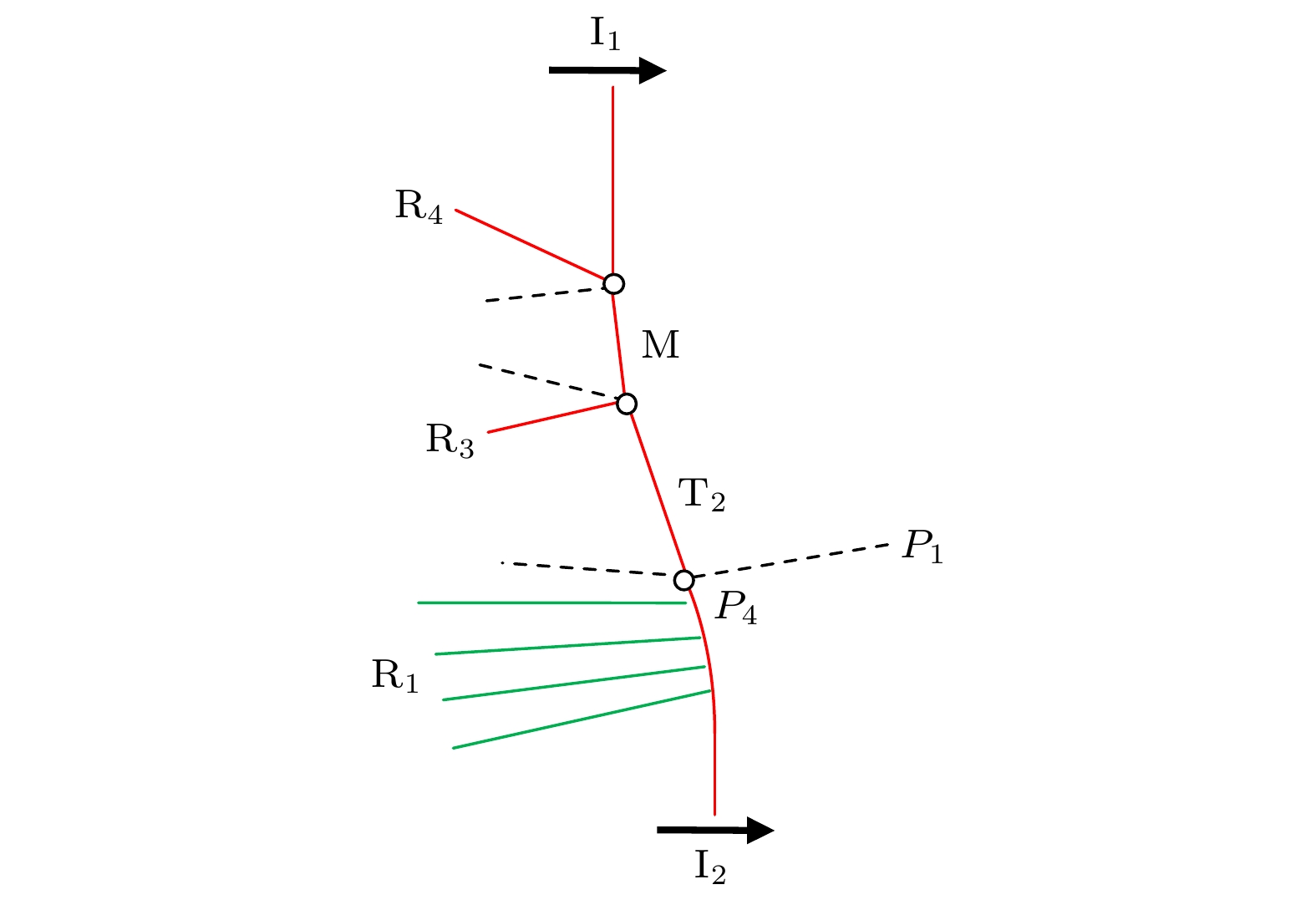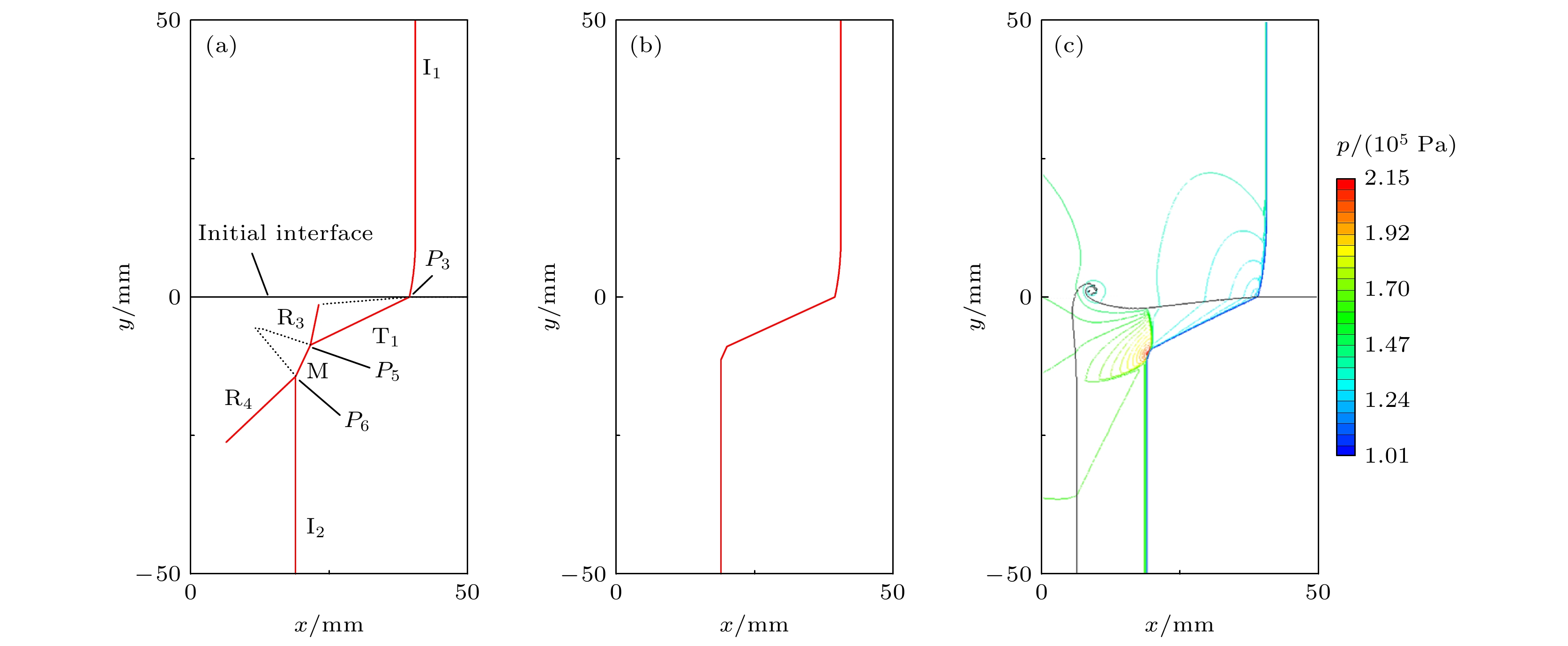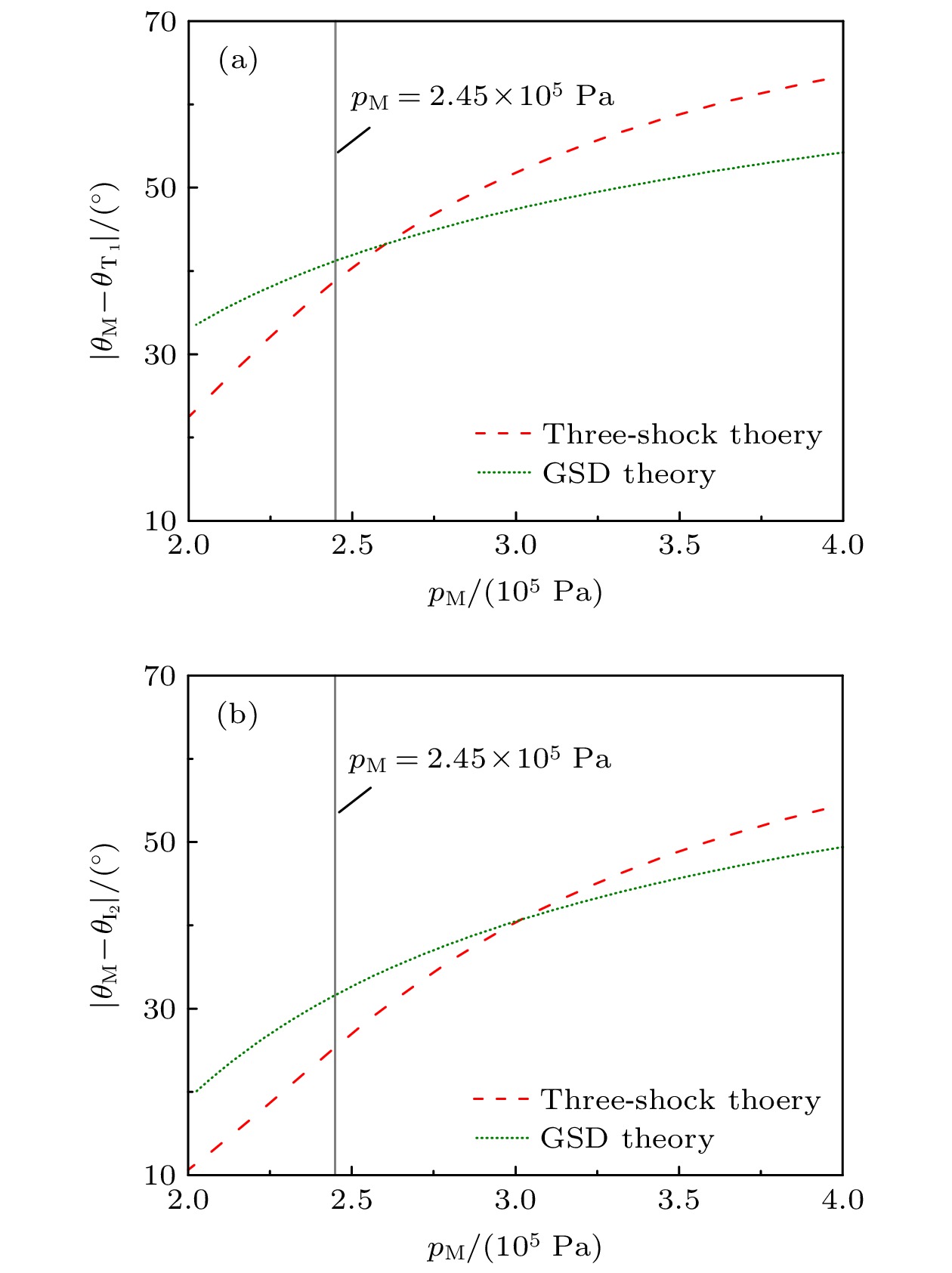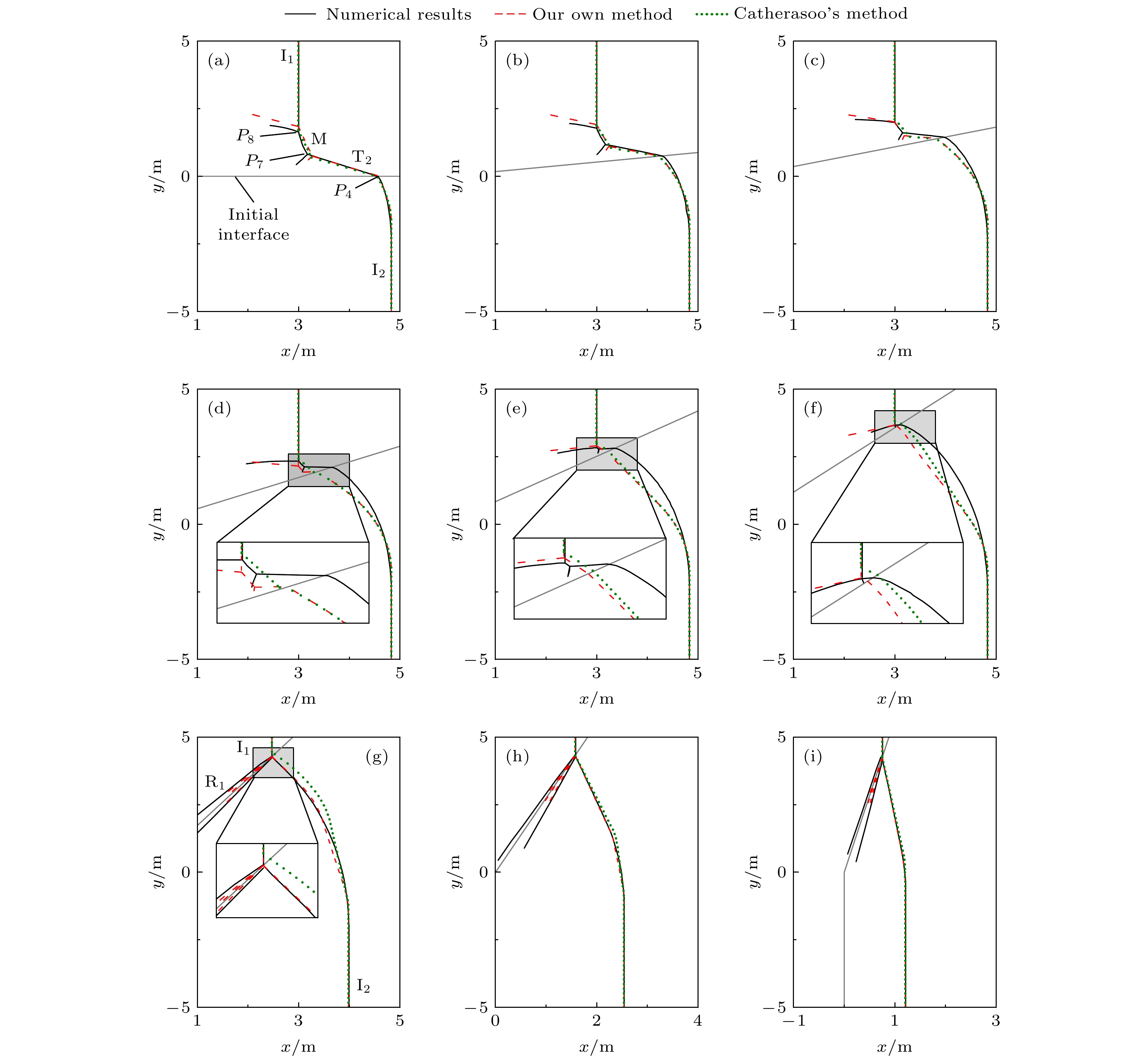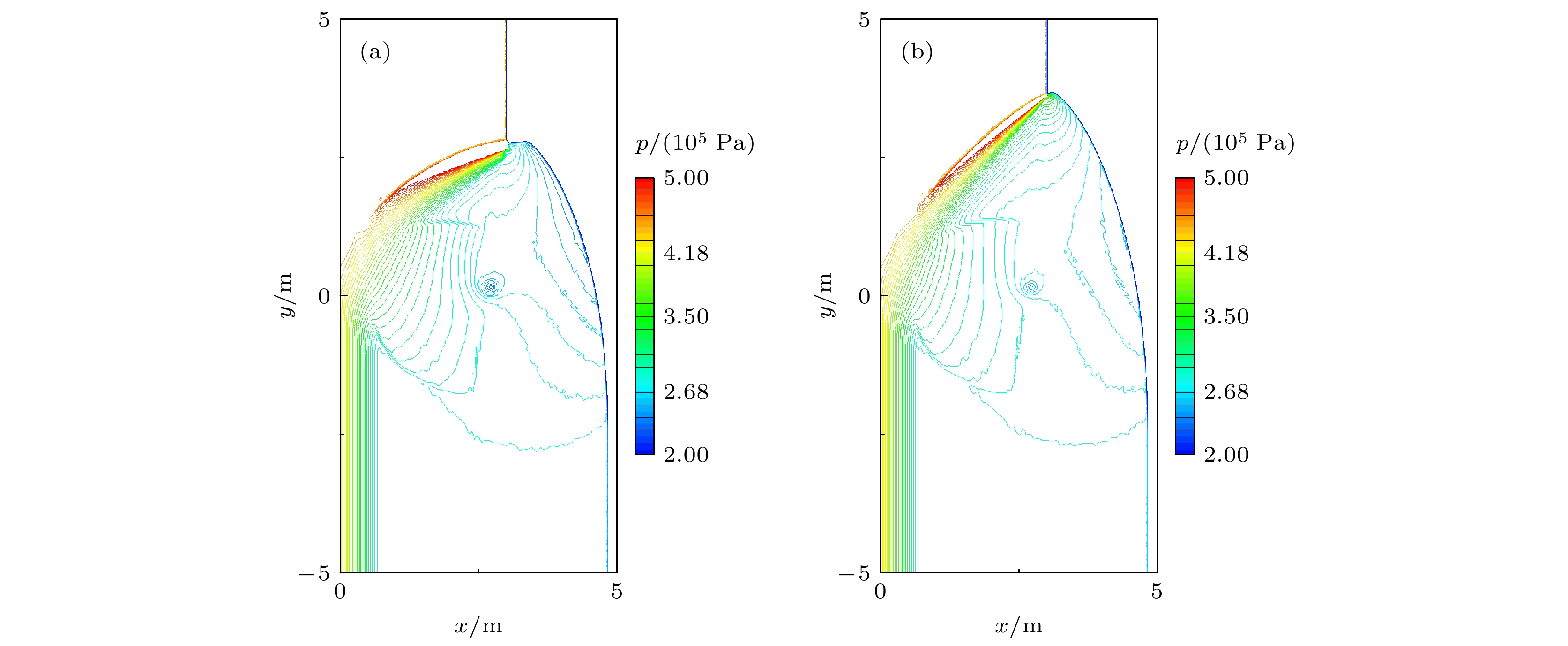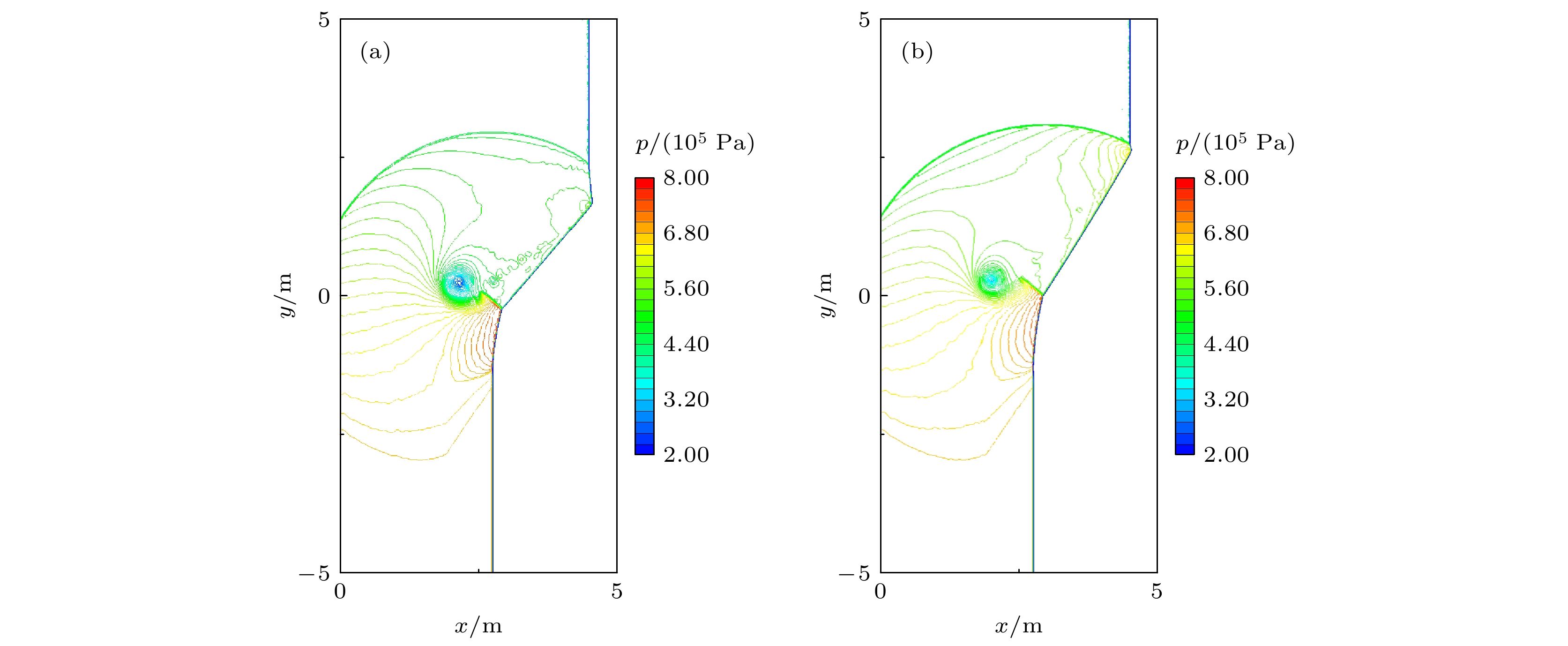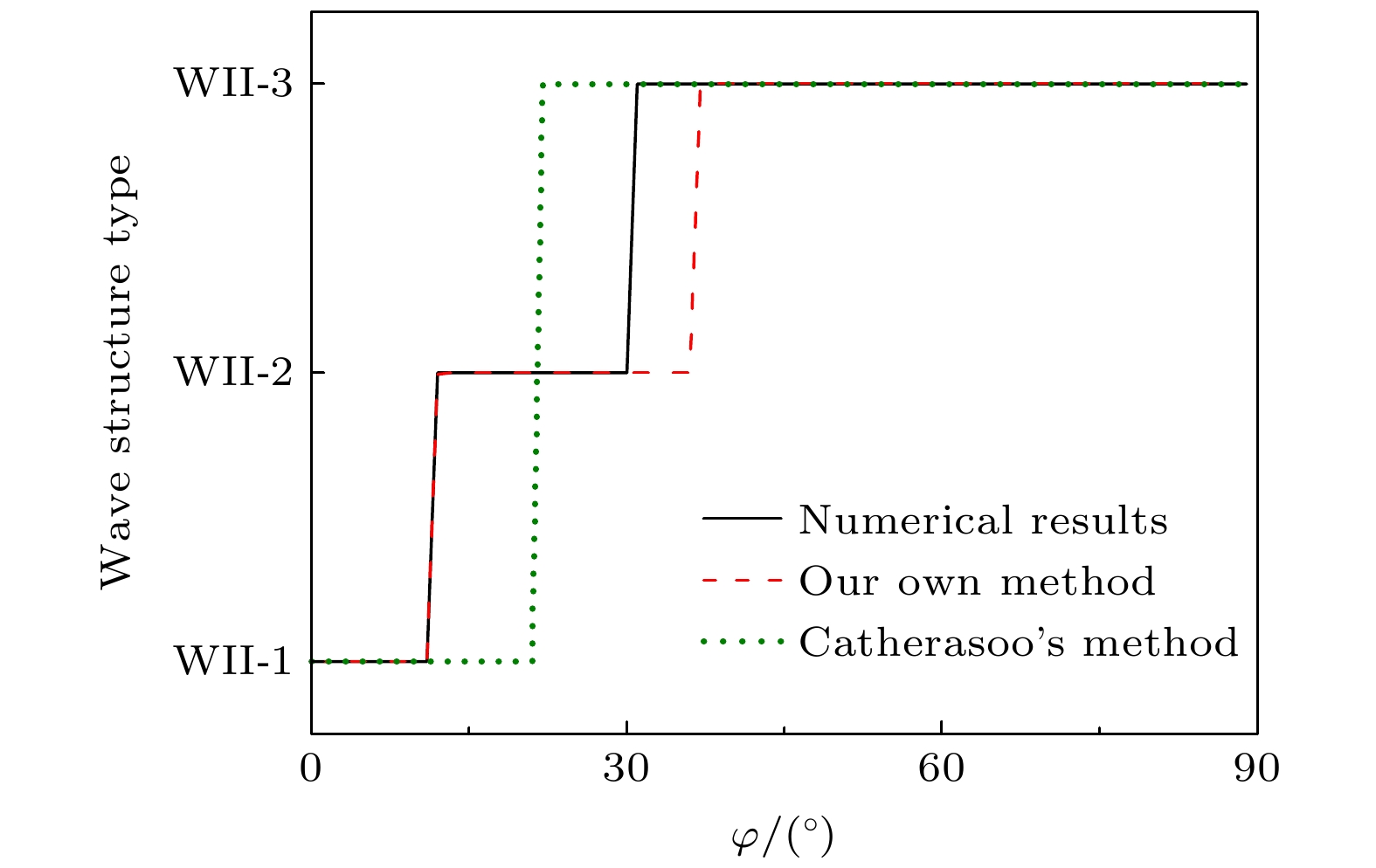-
A theoretical calculation method for wave structures in the flow resulting from the interaction between the two-dimensional planar shock and the material interface is developed. First, the propagation of the shock wave on either side of the interface is analyzed, and two regular refraction types and three irregular ones are identified. Then, according to the relative speed of the perturbations on either side, three different interaction cases are established. Compared with the existing Catherasoo’s method, this method is improved in the following aspects: 1) the influence of the perturbation in the post-shock flow field on the interaction is taken into account, including its type and whether it can catch up and interact with the shock front; 2) the interactions between different waves are calculated mostly based on the exact solutions of the Euler equations, except those involving post-shock subsonic rarefaction waves. This method has been used to investigate the interaction of a Mach number 1.17 shock with an air/SF6 interface, and give wave structures that accord with numerical results and existing experimental data. The angle between the transmitted shock and the horizontal direction is obtained to be in better agreement with experimental data than Catherasoo’s result, and more parameters are obtained, such as the reflected wave and the interface deflection angle. For cases involving a Mach number 2.00 shock with different material density ratios and interface inclination angles, comparisons between theoretical and numerical results show that our method can obtain the type of wave structure more accurately than Catherasoo’s method, and identify a refraction type in which the post-shock strong perturbation catches up with the shock front and a three-wave structure is formed, whereas Catherasoo’s method cannot handle this case. Thus, the results show that the improved method in this work has better applicability and higher accuracy than the existing method in identifying the type of wave structure, and can also provide more information about the wave structures.
-
Keywords:
- shock wave /
- regular/irregular refraction /
- wave structures /
- theoretical calculation
[1] Taub A H 1947 Phys. Rev. 72 51
 Google Scholar
Google Scholar
[2] Polachek H, Seeger R J 1951 Phys. Rev. 84 922
 Google Scholar
Google Scholar
[3] Henderson L F 1966 J. Fluid Mech. 26 607
 Google Scholar
Google Scholar
[4] Ben-Dor G, Igra O, Elperin T 2001 Handbook of Shock Waves (Vol. 2) (London: Academic Press) pp71,72
[5] Jahn R G 1956 J. Fluid Mech. 1 457
 Google Scholar
Google Scholar
[6] Abd-El-Fattah A M, Henderson L F, Lozzi A 1976 J. Fluid Mech. 76 157
 Google Scholar
Google Scholar
[7] Flores J, Holt M 1982 Phys. Fluids 25 238
 Google Scholar
Google Scholar
[8] Henderson L F, Jia-Huan M, Akira S, Kazuyoshi T 1990 Fluid Dyn. Res. 5 337
 Google Scholar
Google Scholar
[9] Henderson L F 1992 Shock Waves 2 103
 Google Scholar
Google Scholar
[10] Abd-El-Fattah A M, Henderson L F 1978 J. Fluid Mech. 86 15
 Google Scholar
Google Scholar
[11] Abd-El-Fattah A M, Henderson L F 1978 J. Fluid Mech. 89 79
 Google Scholar
Google Scholar
[12] Henderson L F 1989 J. Fluid Mech. 198 365
 Google Scholar
Google Scholar
[13] Henderson L F, Colella P, Puckett E G 1991 J. Fluid Mech. 224 1
 Google Scholar
Google Scholar
[14] Henderson L F, Puckett E G 2014 Shock Waves 24 553
 Google Scholar
Google Scholar
[15] Nourgaliev R R, Sushchikh S Y, Dinh T N, Theofanous T G 2005 Int. J. Multiphas. Flow 31 969
 Google Scholar
Google Scholar
[16] Zhai Z G, Wang M H, Si T, Luo X S 2014 J. Fluid Mech. 757 800
 Google Scholar
Google Scholar
[17] Wang M H, Si T, Luo X S 2015 Shock Waves 25 347
 Google Scholar
Google Scholar
[18] Luo X S, Wang M H, Si T, Zhai Z G 2015 J. Fluid Mech. 773 366
 Google Scholar
Google Scholar
[19] Zhai Z G, Li W, Si T, Luo X S, Yang J M, Lu X Y 2017 Phys. Fluids 29 016102
 Google Scholar
Google Scholar
[20] Igra D, Igra O 2018 Phys. Fluids 30 056104
 Google Scholar
Google Scholar
[21] Sadin D V, Davidchuk V A 2020 J. Eng. Phys. Thermophys. 93 474
 Google Scholar
Google Scholar
[22] Onwuegbu S, Yang Z 2022 AIP Adv. 12 025215
 Google Scholar
Google Scholar
[23] Georgievskii P, Levin V, Sutyrin O 2010 Fluid Dyn. 45 281
 Google Scholar
Google Scholar
[24] Georgievskiy P, Levin V, Sutyrin O 2012 Proceedings of the 15th International Symposium on Flow Visualization Minsk, Belarus, June 25-28, 2012 p1
[25] Catherasoo C J, Sturtevant B 1983 J. Fluid Mech. 127 539
 Google Scholar
Google Scholar
[26] Whitham G B 1957 J. Fluid Mech. 2 145
 Google Scholar
Google Scholar
[27] Whitham G B 1959 J. Fluid Mech. 5 369
 Google Scholar
Google Scholar
[28] Schwendeman D W 1988 J. Fluid Mech. 188 383
 Google Scholar
Google Scholar
[29] Toro E F 2009 Riemann Solvers and Numerical Methods for Fluid Dynamics (3rd Ed.) (Berlin, Heidelberg: Springers-Verlag) pp115–151
-
表 1 波T1参数的理论计算结果
Table 1. Theoretical retuslts for parameters of T1.
计算方法 pT1/(105 Pa) uT1/(m·s–1) vT1/(m·s–1) 本文 1.32 15.8 –32.6 Catherasoo 1.21 9.95 –21.6 表 2 波T1与I2作用的理论计算结果
Table 2. Theoretical retuslts for interaction between T1 and I2.
波T1参数 计算方法 α1/(°) α2/(°) pM/(105 Pa) pT1 = 1.32×105 Pa 本文 21.8 37.2 2.45 Catherasoo 24.9 32.0 2.23 pT1 = 1.21×105 Pa 本文 21.3 36.6 2.37 Catherasoo 24.1 30.8 2.17 表 3 不同φ值下波系结构变量(MaI1 = 2.00, ρ2/ρ1 = 0.25)
Table 3. Wave structure parameters for different φ (MaI1 = 2.00, ρ2/ρ1 = 0.25).
φ/(°) 计算方法 ϕ2 α3 α4 d7–8 r4 结果/(°) 偏差/% 结果/(°) 偏差/% 结果/(°) 偏差/% 结果/m 偏差/% 结果/m 偏差/% 0 本文 29.4 –4.42 13.0 –10.1 31.7 10.6 1.13 34.2 4.60 0.86 Catherasoo 28.4 –7.89 12.2 –15.6 29.5 3.01 1.02 22.0 4.54 –0.31 10 本文 29.4 –4.62 8.97 –14.3 22.6 8.86 0.84 34.0 4.33 –0.51 Catherasoo 28.2 –8.54 7.89 –24.6 22.1 6.53 0.87 38.9 4.29 –1.33 20 本文 29.4 –5.12 5.33 –25.4 13.9 2.43 0.54 33.0 4.09 –3.34 Catherasoo 28.1 –9.28 3.97 –44.4 15.4 12.8 0.72 77.5 4.06 –3.89 30 本文 29.4 –9.64 2.01 –54.1 5.74 –27.5 0.24 2.59 3.88 –8.68 Catherasoo 28.1 –13.7 0.37 –91.7 9.12 15.0 0.59 148.7 3.86 –9.00 40 本文 — — — — 4.17 25.9 — — 4.16 –5.15 Catherasoo — — — — 5.02 51.4 — — 4.22 –3.88 50 本文 — — — — 0.82 22.7 — — 4.74 –1.27 Catherasoo — — — — 1.99 197.9 — — 4.86 1.22 60 本文 — — — — — — — — 4.94 –0.06 Catherasoo — — — — 0.71 — — — 5.05 2.12 70 本文 — — — — — — — — 4.60 –0.85 Catherasoo — — — — — — — — 4.60 –0.85 80 本文 — — — — — — — — 4.31 –0.98 Catherasoo — — — — — — — — 4.31 –0.98 表 4 不同φ值下波系结构变量(MaI1 = 2.00, ρ2/ρ1 = 4.00)
Table 4. Wave structure parameters for different φ (MaI1 = 2.00, ρ2/ρ1 = 4.00).
φ/(°) 计算方法 ϕ1 α1 α2 d5–6 r3 结果/(°) 偏差/% 结果/(°) 偏差/% 结果/(°) 偏差/% 结果/m 偏差/% 结果/m 偏差/% 0 本文 29.6 –2.32 13.3 –11.4 31.2 11.3 0.99 40.4 4.27 0.83 Catherasoo 29.4 –3.02 12.0 –20.0 31.0 10.5 1.04 48.1 4.17 –1.61 10 本文 29.5 –2.64 17.8 –9.35 40.2 8.18 1.22 31.2 4.56 0.69 Catherasoo 29.8 –1.64 16.8 –14.2 39.6 6.55 1.23 32.5 4.46 –1.51 20 本文 29.4 –1.14 23.0 –6.63 49.8 — 1.44 — 4.94 1.78 Catherasoo 30.2 1.73 22.0 –10.9 48.8 — 1.44 — 4.78 –1.53 30 本文 29.5 3.20 28.0 –6.96 59.7 — 1.71 — 5.32 1.96 Catherasoo 29.9 4.53 27.4 –9.10 58.4 — 1.66 — 5.19 –0.68 40 本文 27.5 3.74 32.6 –9.07 69.2 — 1.97 — 5.86 0.14 Catherasoo 27.4 3.07 33.4 –6.81 67.9 — 1.84 — 5.86 0.14 50 本文 22.8 1.86 38.1 –8.40 78.5 — 1.79 — 5.82 –0.16 Catherasoo 23.3 4.49 39.9 –3.99 77.2 — 1.65 — 5.82 –0.16 60 本文 17.6 0.12 44.0 — 88.0 — 1.36 — 5.24 0.01 Catherasoo 18.3 3.71 46.8 — 86.5 — 1.22 — 5.24 0.01 70 本文 12.0 0.36 50.1 — 97.7 — 0.84 — 4.38 –0.45 Catherasoo 12.5 4.35 54.0 — 95.8 — 0.73 — 4.38 –0.45 80 本文 6.10 –0.64 56.4 — 107.5 — 0.45 — 4.31 –0.73 Catherasoo 6.35 3.47 60.9 — 105.0 — 0.39 — 4.31 –0.73 -
[1] Taub A H 1947 Phys. Rev. 72 51
 Google Scholar
Google Scholar
[2] Polachek H, Seeger R J 1951 Phys. Rev. 84 922
 Google Scholar
Google Scholar
[3] Henderson L F 1966 J. Fluid Mech. 26 607
 Google Scholar
Google Scholar
[4] Ben-Dor G, Igra O, Elperin T 2001 Handbook of Shock Waves (Vol. 2) (London: Academic Press) pp71,72
[5] Jahn R G 1956 J. Fluid Mech. 1 457
 Google Scholar
Google Scholar
[6] Abd-El-Fattah A M, Henderson L F, Lozzi A 1976 J. Fluid Mech. 76 157
 Google Scholar
Google Scholar
[7] Flores J, Holt M 1982 Phys. Fluids 25 238
 Google Scholar
Google Scholar
[8] Henderson L F, Jia-Huan M, Akira S, Kazuyoshi T 1990 Fluid Dyn. Res. 5 337
 Google Scholar
Google Scholar
[9] Henderson L F 1992 Shock Waves 2 103
 Google Scholar
Google Scholar
[10] Abd-El-Fattah A M, Henderson L F 1978 J. Fluid Mech. 86 15
 Google Scholar
Google Scholar
[11] Abd-El-Fattah A M, Henderson L F 1978 J. Fluid Mech. 89 79
 Google Scholar
Google Scholar
[12] Henderson L F 1989 J. Fluid Mech. 198 365
 Google Scholar
Google Scholar
[13] Henderson L F, Colella P, Puckett E G 1991 J. Fluid Mech. 224 1
 Google Scholar
Google Scholar
[14] Henderson L F, Puckett E G 2014 Shock Waves 24 553
 Google Scholar
Google Scholar
[15] Nourgaliev R R, Sushchikh S Y, Dinh T N, Theofanous T G 2005 Int. J. Multiphas. Flow 31 969
 Google Scholar
Google Scholar
[16] Zhai Z G, Wang M H, Si T, Luo X S 2014 J. Fluid Mech. 757 800
 Google Scholar
Google Scholar
[17] Wang M H, Si T, Luo X S 2015 Shock Waves 25 347
 Google Scholar
Google Scholar
[18] Luo X S, Wang M H, Si T, Zhai Z G 2015 J. Fluid Mech. 773 366
 Google Scholar
Google Scholar
[19] Zhai Z G, Li W, Si T, Luo X S, Yang J M, Lu X Y 2017 Phys. Fluids 29 016102
 Google Scholar
Google Scholar
[20] Igra D, Igra O 2018 Phys. Fluids 30 056104
 Google Scholar
Google Scholar
[21] Sadin D V, Davidchuk V A 2020 J. Eng. Phys. Thermophys. 93 474
 Google Scholar
Google Scholar
[22] Onwuegbu S, Yang Z 2022 AIP Adv. 12 025215
 Google Scholar
Google Scholar
[23] Georgievskii P, Levin V, Sutyrin O 2010 Fluid Dyn. 45 281
 Google Scholar
Google Scholar
[24] Georgievskiy P, Levin V, Sutyrin O 2012 Proceedings of the 15th International Symposium on Flow Visualization Minsk, Belarus, June 25-28, 2012 p1
[25] Catherasoo C J, Sturtevant B 1983 J. Fluid Mech. 127 539
 Google Scholar
Google Scholar
[26] Whitham G B 1957 J. Fluid Mech. 2 145
 Google Scholar
Google Scholar
[27] Whitham G B 1959 J. Fluid Mech. 5 369
 Google Scholar
Google Scholar
[28] Schwendeman D W 1988 J. Fluid Mech. 188 383
 Google Scholar
Google Scholar
[29] Toro E F 2009 Riemann Solvers and Numerical Methods for Fluid Dynamics (3rd Ed.) (Berlin, Heidelberg: Springers-Verlag) pp115–151
Catalog
Metrics
- Abstract views: 7624
- PDF Downloads: 93
- Cited By: 0














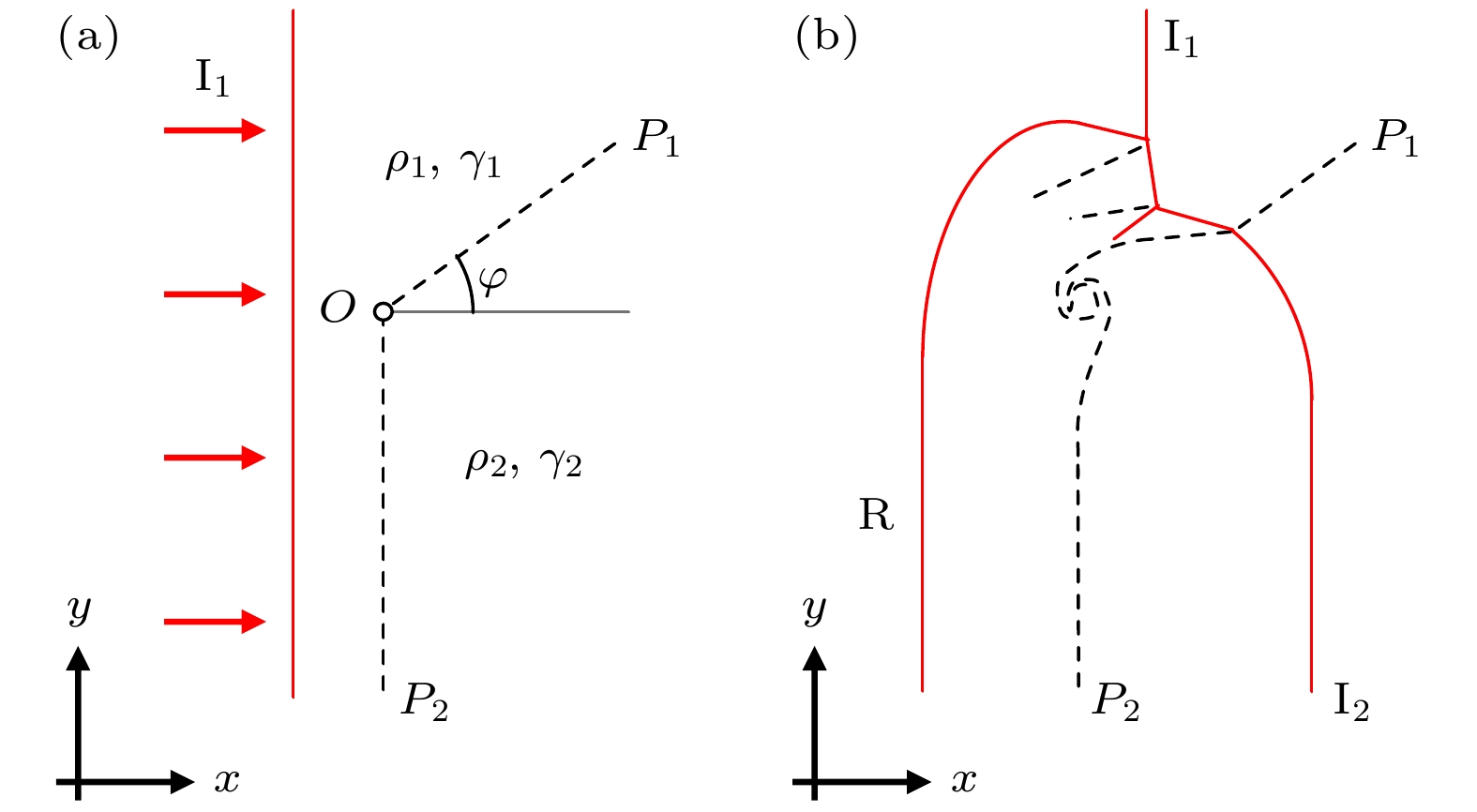
 DownLoad:
DownLoad:
